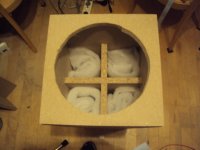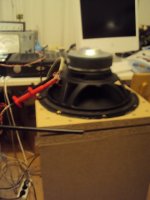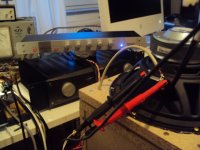Is that the Peerless SLS-10 woofer?
I found floor reflections to definitely be a detriment to speakers which did not have low mounted woofers, or multiple woofers extending down to within close to the floor - it's the big deep dip at around ~200Hz which I think was bothering me. I filled in the floor bounce cancellation with a low mounted woofer and found a definite improvement in sound quality.
This was BEFORE I measured the speakers from the listening position and before I knew what "floor bounce cancellation" was.
Now, I did not do thorough double blind testing to actually be certain that I specifically dislike the floor bounce cancellation, but I did clearly prefer the solution which did not have it, and found in my general experience that one characteristic of speakers I prefer are ones which have a design that inherently limit or eliminate FBC.
I never found floor reflection to be an audible problem - except when I had seen a measurement of it beforehand 😉.
I found floor reflections to definitely be a detriment to speakers which did not have low mounted woofers, or multiple woofers extending down to within close to the floor - it's the big deep dip at around ~200Hz which I think was bothering me. I filled in the floor bounce cancellation with a low mounted woofer and found a definite improvement in sound quality.
This was BEFORE I measured the speakers from the listening position and before I knew what "floor bounce cancellation" was.
Now, I did not do thorough double blind testing to actually be certain that I specifically dislike the floor bounce cancellation, but I did clearly prefer the solution which did not have it, and found in my general experience that one characteristic of speakers I prefer are ones which have a design that inherently limit or eliminate FBC.
Last edited:
Joachim,
Very nice! Where was the mic located during the measurement? Was any smoothing applied to the data?
Very nice! Where was the mic located during the measurement? Was any smoothing applied to the data?
Last edited:
I found floor reflections to definitely be a detriment to speakers which did not have low mounted woofers, or multiple woofers extending down to within close to the floor - it's the big deep dip at around ~200Hz which I think was bothering me. I filled in the floor bounce cancellation with a low mounted woofer and found a definite improvement in sound quality.
You are quoting me from 60 posts ago. Back then we were mostly talking about spatial deficiencies, not timbral ones. I don't deny that floor bounce results in a frequency response dip, but it does not drag your spatial impression of an upright bass to the floor IMHO.
Yes, they are Peerless SLS-10 woofers.
Soon, the response was measured 2cm from the membrane of the top woofer. I used Praxis flex window option so the response is smoothed by a flexible window. I measured also in 50cm distance and that looked good too.
I build speakers with and without woofers close to the floor and also speakers that have woofers spread vertically and horizontally. There may be other reasons then the floor bounce why speakers with woofers close to the floor sound diffent. I think the floor bounce is not a big problem aurally. It ocures all the time when a natural instrument is playing. It can also be reduced somewhat by using damping material on the floor.
Soon, the response was measured 2cm from the membrane of the top woofer. I used Praxis flex window option so the response is smoothed by a flexible window. I measured also in 50cm distance and that looked good too.
I build speakers with and without woofers close to the floor and also speakers that have woofers spread vertically and horizontally. There may be other reasons then the floor bounce why speakers with woofers close to the floor sound diffent. I think the floor bounce is not a big problem aurally. It ocures all the time when a natural instrument is playing. It can also be reduced somewhat by using damping material on the floor.
Last edited:
I measured the woofer again after 2 hours on break in. Qts is now a bit over 0.8 and fundamental resonance is at 40Hz. I think more break in will get the cabinet up to target and we are set.
Attachments
Your drivers are mounted very close to the sidewalls of your enclosure, and seeing as I've found that mounting midrange drivers too close to the speaker cabinet's walls causes standing waves to be more readily fed back through the driver's cones, I would wonder if the same would hold true with the lower frequencies of bass drivers.
The cabinet is so small that standing waves can not happen in the passband. There is only preasure. At higher frequencies the damping material is very effective. If there whould be standing waves or cabinet resonances it whould show in the impedance curve as wrincles but there are no. The cone breakup is visiible over 2kHz so the impedance curve is a good measure of resonances. It is like "looking" into the cabinet.
Thank you for your explanation. What you say makes a lot of sense, but I'm a bit stubborn sometimes and I'm still thinking that the close walls would have some type an influence on the cone. Perhaps someday I'll cobble up a pair of bass cabinets - one with close walls and one without - and do an A/B listening comparison to see for myself if there are any audible effects.
Yes, the bigger cabinet will cause you more trouble. Small box: small trouble, big box: big trouble; Peter Walker.
I did some more work on the ZDL woofer. i will use it with an active crossover. Amp power got cheep so did active crossovers for example from Reckhorn. A deep crossover needs big coils and caps and besides the losses those parts are not cheep so actually an active version will not be more expensive but much better performing. For the measurements shown i used a Sonics Drömmen crossover i did some yeras ago based on the Thomessen that is unfortunately not availlabe any more but there are good substitudes. See the result i got with and without EQ. Rolloff is 12B/Oct. and there is no sight of a resonance. So far for CMP behaviour of an Isobaric.
Attachments
Soon, i will not win a volume contest and the EQ is optional. Remember, this is for nearfield. The woofer has decent excursion. I whould say 20mm P-P without making much noise.
I am just curious because most drivers seem to bottom out at very low voltages, mostly within 15 volts. The shape of the BL curve seems to contribute to distortion pretty significantly, and in different ways.
From just looking at BL curves, I don't see any reason why it would except for asymmetry compensation. But again, it's just a different tradeoff consideration.
Last edited:
It compensates for asymmetric distortion, hence reducing second harmonic by 10dB. I measured that. Third is not affected.
looking at just BL, provided it is symmetric around "zero" you are right but there is also the suspension and Le modulation.
I have been looking at some data, and noticed that in most cases BL related distortion seem higher than suspension and Le, also, as I recall Mr. Klippel had addressed, BL related distortion have much wider bandwidth influence than suspension and Le nonlinearity.
I actually think that a magnetic field can be done very well with finite elemente analysis.
The biggest problem usually is the suspension. Le modulation does not matter much in the bass, sure. That is more a higher frequency distortion.
The biggest problem usually is the suspension. Le modulation does not matter much in the bass, sure. That is more a higher frequency distortion.
- Status
- Not open for further replies.



